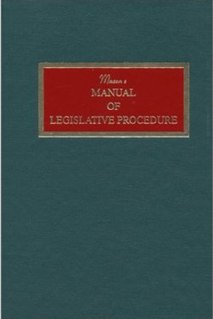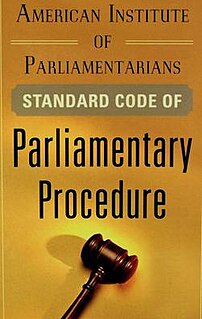In parliamentary procedure, an adjournment ends a meeting. It could be done using a motion to adjourn.
In deliberative bodies a second to a proposed motion is an indication that there is at least one person besides the mover that is interested in seeing the motion come before the meeting. It does not necessarily indicate that the seconder favors the motion.
In parliamentary procedure, unanimous consent, also known as general consent, or in the case of the parliaments under the Westminster system, leave of the house, is a situation in which no member present objects to a proposal.
In parliamentary procedure, the previous question is generally used as a motion to end debate on a pending proposal and bring it to an immediate vote. The meaning of this specialized motion has nothing to do with any question previously considered by the assembly.
In parliamentary procedure, reconsideration of a motion may be done on a matter previously decided. The motion to "reconsider" is used for this purpose. This motion originated in the United States and is generally not used in parliaments. A special form of this motion is reconsider and enter on the minutes.
In parliamentary procedure, the motion to postpone indefinitely is a subsidiary motion used to kill a main motion without taking a direct vote on it. This motion does not actually "postpone" it.
In parliamentary procedure, a motion to appeal from the decision of the chair is used to challenge a ruling of the chair.
In parliamentary procedure, a suspension of the rules allows a deliberative assembly to set aside its normal rules to do something that it could not do otherwise. However, there are rules that cannot be suspended.
In parliamentary procedure, a motion to postpone to a certain time is used to delay action on a pending question until a different day, meeting, hour or until after a certain event. Then, when that time comes, the consideration of the question is picked up where it was left off when it was postponed.
In parliamentary procedure, a motion for division of a question is used to separate a motion into a set of motions.
Debate in parliamentary procedure refers to discussion on the merits of a pending question; that is, whether it should or should not be agreed to. It is also commonly referred to as "discussion".
In a deliberative assembly, disciplinary procedures are used to punish members for violating the rules of the assembly.
In disciplinary procedures, the motion to declare the chair vacant is used as a remedy to misconduct or dereliction of duty by the chair of a deliberative assembly, when the rules allow it. It is usually combined with a motion to elect a new chair.
In parliamentary procedure, requests and inquiries are motions used by members of a deliberative assembly to obtain information or to do or have something done that requires permission of the assembly. Except for a request to be excused from a duty, these requests and inquiries are not debatable nor amendable.
The motion to pass on is a dilatory parliamentary motion used in legislative procedure. It is distinct from the motion to table or to postpone to a certain time. The motion delays consideration of a matter for a later time without indicating prejudice with respect to it. According to Mason's Manual, matter passed on in this way remains subject to subsidiary motion. The motion to pass on is not subject to debate, but requires a majority vote.
Parliamentary procedure is the body of rules, ethics, and customs governing meetings and other operations of clubs, organizations, legislative bodies, and other deliberative assemblies. General principles of parliamentary procedure include rule of the majority with respect for the minority.
In parliamentary procedure, the verb to table has the opposite meaning in different countries:



